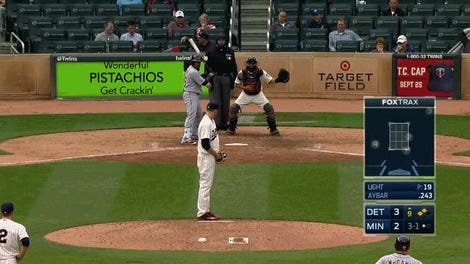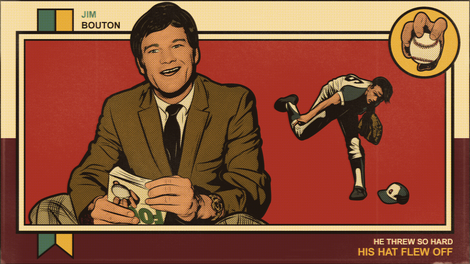Major League Baseball commissioner Rob Manfred, in collaboration with his quisling associates in the players’ union, is apparently ready to do away with the normal and basic baseball act of four balls leading to a walk. He and they have agreed to a scheme by which the intentional walk doesn’t physically occur, but is simply motioned for from the dugout.
This is revolting, not just because Manfred is a dope who doesn’t understand the first thing about why people enjoy the sport he’s in charge of, but because the intentional walk is good baseball. By its nature, the traditional intentional walk call sets up a comic situation and then, once in a while, delivers.
Over here you have the pitcher and catcher, who are supposed to be attempting to get the batter out, going against their own natures by not doing so and making a great show of it. We’re not good enough, they say. We’ve failed and won’t even try. Over there you have both the irritated batter and the laws of probability, which dictate that a thing done often enough by enough people will, every so often, get fucked up in some spectacular way—a probability ratcheted to greater likelihood by the pitcher and catcher having decided to abandon their crisp, familiar, professional exchange in favor of an awkward impersonation of civilian doofuses playing backyard catch.
And so from time to time you get something like Miguel Cabrera driving in the go-ahead run on a misplaced eephus pitch or some idiot air-mailing one to the backstop and allowing a runner to scamper home, and it’s much funnier than your typical lowlight-reel play precisely because the cowards have been punished for their cowardice.
Even if the intentional walk weren’t inherently good, though, that wouldn’t matter so far as rules meant to govern it are concerned, because it’s part of the normal course of the game. The margins between an ordinary walk and an unintentional intentional walk, and between an unintentional intentional walk and an intentional walk, are extremely thin. Sometimes you’ll see a pitcher, part of the way into an unintentional unintentional intentional walk, get told by his manager to stop wasting everyone’s time and just put the batter on first. At this point the catcher will step out behind the opposite batter’s box and signal for a wide, wide batting-practice pitch. If everything goes for the best, the batter will reach out and loop one for a base hit; if not, a pitcher will have just thrown four balls and the batter will be on first, as happens all the time. Either way, the pitcher-batter interaction will have involved balls being thrown outside the strike zone, and the hitter having considered whether or not to offer at them. That’s how baseball works.
In place of that physical reality, the commissioner and his enablers now offer quantum indeterminacy. We should, he and they say, pretend that something that hasn’t yet happened has happened. Comedy is easy; baseball is hard; and so pitchers shouldn’t have to actually throw four pitches outside the strike zone, as it may speed up the game for the benefit of the young teen millennials.
An automatic intentional walk would reward the team that’s trying to duck a dangerous batter by eliminating all other sources of risk from the scenario. It would take away from the hitting team any chance of advancing on a wild pitch or a stolen base—or the advantage, when the next hitter comes to bat, of the pitcher having to rediscover his normal motion and find the strike zone again.
The proposal, in short, takes as a given that a signal from the dugout can and should override the game as played on the field. It removes certain acts of normal baseball from the realm of normal baseball.
It does all this, worst of all, in service of claims that marking a category of normal pitching as isolable from all other normal pitching will address the anger of the public over major-league games being full of time-wasting bullshit.
Now, major-league games surely are full of time-wasting bullshit—the average game these days runs 15 minutes or so longer than it did 30 years ago—but that’s almost entirely down to batters wandering around outside the batter’s box, pitchers wandering around the mound between pitches, and the higher incidence of pitcher substitutions, especially in the late innings of games.
Rob Manfred, as the commissioner of Major League Baseball, could fix a lot of this not by cooking up new rules, but simply by demanding that umpires actually enforce the actual rules that are already in the actual rulebook, which involve pitchers being liable for having balls called on them for wasting time and batters being liable for having strikes called on them for doing the same. See here:
He hasn’t done so, though, because even with near-dictatorial power, getting umpires to call strikes on batters for wandering around knocking the dirt off their cleats, or to call balls on pitchers for wandering around greasing up the ball, seems impossible. It would mean admitting that the pace-of-game problem is a cultural one, caused by the league’s own refusal to intervene in the players’ bad habits. It would require the courage to tell pitchers and hitters, over and over again, to quit hiding behind their own time-wasting gamesmanship and play ball.
Instead, the commissioner and the players are blaming the intentional walk—and thereby making the game a little more boring. To get rid of 90 seconds of soft-tossing, they will remove the chance that anything amusing or unexpected might happen.
This is what the empty worship of control and efficiency gets you. It is the product of the same league office that just floated the idea of beginning extra innings with a runner on second base (because heaven forbid a tie game should stretch out indefinitely with the outcome hanging in the balance).
Defending that proposal, Joe Torre, who now works for the league under the title of “Chief Baseball Officer,” said, “It’s not fun to watch when you go through your whole pitching staff and wind up bringing a utility infielder in to pitch.” This is hilariously and scarily wrong: Bringing a position player on to pitch with the game on the line is tremendous fun to watch, the sort of thing that turns a routine regular-season game into a once-in-a-lifetime memory for the fans.
No one who cares about baseball should be looking for ways to forestall entertaining weirdness. YouTube is full of clips of intentional walks gone wrong. Baseball gone awry isn’t the matter, and baseball isn’t the matter; the matter is all the shit that isn’t baseball and makes games airy and loose and overlong that baseball fans don’t want to watch, baseball players have no affinity for, and baseball people won’t do away with for no reason anyone can tell. Forget about tampering with the actual mechanics of actual at-bats! Tell batters to hit and pitchers to pitch and umpires to enforce the rules and you might, who knows, get on to something.






